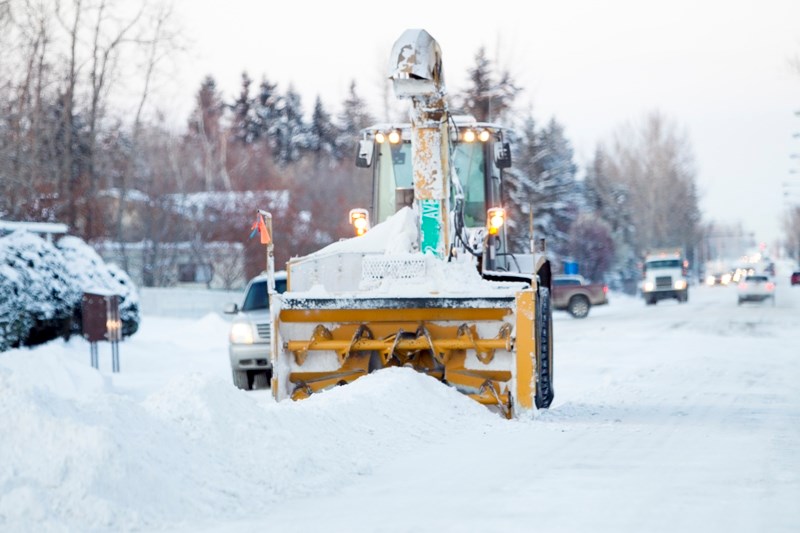The last significant snowfall in Olds, prior to the blizzard that struck Southern Alberta on December 1 and 2, was on Nov. 16.
Although Environment Canada data on how much snow fell that day is incomplete, enough of the white stuff came down to make local roadways dangerously slippery and a number of local events, including an Olds Grizzlys home game, were cancelled.
Yet on many streets throughout the community, there still was a thick, hard, bumpy covering of snow as of the weekend of Nov. 30 and Dec. 1.
And some of that snow remains from other significant snowfalls that struck Olds on Nov. 2 and even as far back as Oct. 27.
Norm McInnis, the Town of Olds' chief administrative officer, said the town has received few formal complaints about plowing since the snow season began in Olds.
But, he added, the town does receive “lots of comments” from those both happy and frustrated with the town's snow removal service.
Because of limited equipment and cash, the town won't start clearing snow until a certain accumulation “threshold” is met, McInnis said, and this threshold is different in various areas of the community since certain parts of town are of higher priority for snow removal than others.
“It's a resource allocation piece. Safety and mobility are the goals,” he said. “If the snow is significant enough where it impacts mobility and safety, there's a different threshold.”
Schools and the hospital are in the high priority category along with major thoroughfares such as 50 Avenue and 54 Avenue and areas of the downtown core stretching from Highway 27 south to 54 Street and from 49 Avenue west to 52 Avenue.
According to the town's snow removal policy, snow will be “dealt with” in a high priority area when seven centimetres or more has fallen within 24 hours, with removal work beginning within 24 hours of the snowfall event.
The residential area west of the downtown core, as well as the industrial area north of Highway 27 and east of 57 Avenue, are designated as medium priority.
Snow removal work in medium priority areas would begin 48 hours after 15 centimetres or more has fallen in a 24-hour period.
And the residential areas such as those east of 49 Avenue and southwest of the downtown core are designated as low priority.
In these areas, snow would be dealt with when driving becomes difficult due to ruts in the snow cover or the depth of the snow, or when 20 centimetres or more has fallen in a 72-hour period.
No timeline is given in the policy for when snow removal work would begin if such conditions occur in a low-priority area.
Even if a low-priority residential street isn't completely cleared, however, town crews will often clear a “driving lane” depending on how much snow has fallen,
McInnis said.
The major obstacles to the timeliness and thoroughness of snow removal, he added, are the costs involved in plowing, especially overtime costs for personnel, and the number of snow removal equipment the town owns.
The town currently has a grader, a snow blower on a tractor and four smaller vehicles such as Bobcats for snow removal.
“When big snowstorms hit like this and there's an expectation that buses are running the next morning, that grader and that snow blower can only move so fast,” McInnis said.
Another large cost comes from renting trucks to cart away snow following a large storm.
McInnis said the rental cost of the trucks is roughly $12,000.
Under the snow removal policy, the town can only use “town forces when the Town owns the equipment required and in sufficient quantity to allow the timeliness specified to be met.”
The town cannot have crews working overtime “unless deemed necessary” and snow removal efforts must “not exceed the allotted budget without approval from council,” the policy states.
McInnis said the town's snow removal wish list includes more manpower and another grader and blower to “open up those priority routes twice as fast as we can now.”
“We're almost close to the point where a second crew would be nice. We haven't made that ask yet, but typically we can work it out with our one grader and we've got a big snow blower.”
While the proposed 2014 town budget doesn't have an exact breakdown of snow removal costs, it does list $1,726,852 for road expenses, which includes snow clearing, with $80,000 proposed for the rental of trucks used to haul away snow and $20,000 for granular supplies such as salt.
And although the town's sidewalk snow removal policy for any sidewalk at a town facility lists reducing “the Town's exposure to liability claims” as one of its objectives, McInnis said the town would not be liable if someone fell and was injured on a community roadway that was not cleared of snow.
People using the town's streets, he added, are expected to take the proper precautions where conditions are slippery.
“We're all in this together,” McInnis said. “We have a level of service, we think that level of service is right and we as individuals need to understand that. Wear the proper boots and take care.”
McInnis said the town has worked with organizations such as the Olds and District Chamber of Commerce and Uptowne Olds to make sure the town's snow removal policy and level of service are appropriate.
Town staff will also review the current policy with the town's new council in the future and if the community voices a need for improved snow removal efforts, that need would be addressed, he said.
“If it becomes a big issue, we'll take a request to council for upping the level of service.”



